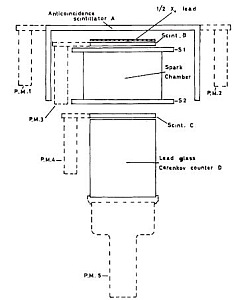Purpose of the flight and payload description
The objective of the experiment was to study the high energy part of the gamma ray spectrum between 200 MeV and 10 GeV, using balloon-borne detectors.
At left can be seen a scheme of the detector. Half a radiation length of lead was used to convert the incoming gamma-rays into e+/e- pairs. The electronic logic for a gamma-ray was ABCD, and all events of this type which exceeded the discriminator level of D (>50 MeV) triggered the spark chamber gaps S1 and S2 and enabled the pulse height information from D to be read out. The spark chamber was of the multi-wire grid type. The spark location was determined using the magnetostrictive wire technique and the coordinates were read out in a digital form. The angular resolution of the detector was limited by multiple Coulomb scattering in the converter material at the lower energy end of the spectrum and by the spark chamber geometry at the higher energies; it ranged from 5º at 200 MeV to 3º at 1 GeV and above.
The energy of the incoming gamma-ray was measured in element D, a 10 radiation length deep cylindrical block of Schott SF6 lead-glass, coupled to a 5 inch diameter photomultiplier tube. The detector had a sensitive area of 125 cm2 and a geometric opening angle to the zenith of 45º. The overall detector efficiency for gamma-rays was 19 % at 200 MeV, rising to 21 % at 1 GeV. Aspect information for each gamma-ray event was determined using a three-axis ?ux-gate magnetometer, and cross checked using a solar sensor. Inflight calibration for the lead-glass calorimeter and the spark chamber electronics was also provided.
Details of the balloon flight
Balloon launched on: 2/9/1971
Launch site: University of Zambia, Lusaka, Zambia
Balloon launched by: Physics Department, Imperial College, London
Balloon manufacturer/size/composition: Zero Pressure Balloon
End of flight (L for landing time, W for last contact, otherwise termination time): 2/9/1971
Landing site: Leaker balloon
This detector was ?own from Lusaka, Zambia, on February 9, 1971. High stratospheric winds prevented longer exposure times. The balloon reached an altitude of 11 mbar and then sank slowly because of a leak in the fabric. Thus, useful data were recorded only between 06:04 UTC and 07:20 UTC.
External references
- A three-axis magnetometer with digital readout, suitable for balloon borne apparatus Nuclear Instruments and Methods - Volume 105, Issue 2, Pag. 371
- Physical Sciences: Galactic Gamma-radiation between 200 MeV and 10 GeV Nature, Volume 238, Issue 5358, pp. 31-33 (1972)
13024If you consider this website interesting or useful, you can help me to keep it up and running with a small donation to cover the operational costs. Just the equivalent of the price of a cup of coffee helps a lot.


